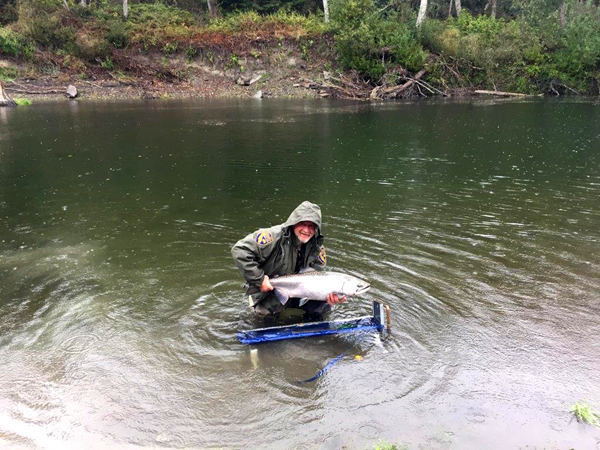 Click here to view full PDF article.
Click here to view full PDF article.
In Northern California lies the Mad River, stretching 113 miles to the Pacific Ocean. The large streams and heavy water flow create the perfect environment for migrating steelhead and salmon but often cause problems for weirs.
Michael D. Sparkman, a Research and Monitoring Biologist for the California Department of Fish and Wildlife (CDFW), says, “We’ve never known how many fish have run up these rivers.” That is until he discovered a new way to monitor and count fish from a friend at the Alaska Department of Fish and Game (ADFG).
In Alaska, Sparkman and his friend worked in the turbid waters of Copper River, and when Sparkman first saw the DIDSON at work he said, “Oh wow! This can see through that? This is like a godsend. I’ve been waiting for something like this.”
“I was really excited about this technology, because weirs just blow out,” Sparkman explains further when discussing the DIDSON sonar technology. Now, “we use [the ARIS Explorer and DIDSON] to count returning salmon and steelhead.”
Sparkman mentions in his latest study, “Sonar Estimation of Adult Steelhead: Various Methods to Account for Kelts in Determining Total Escapement,” that he chose to use Sound Metrics’ sonar technology over weirs, because they can operate in larger streams and rivers as well as in higher flows. Sonars are also “more cost effective than weirs over time” and don’t back up fish.
Thanks to Federal funding, California Department of Fish and Wildlife was able to purchase multiple DIDSON and ARIS systems due to the low population counts and steelhead being listed as a “threatened” species by the United States Environmental Protection Agency (EPA).
Over the years, Sparkman has used ARIS Explorer and its predecessor DIDSON in a number of research studies – his latest of which he presented at the 2018 Pacific Coast Steelhead Management Meeting.
The study accounts for the downstream migration of kelts and milling fish in the Mad River over the course of each season. According to Sparkman, the stream can get quite murky from the particles that come from the hillside, but the ARIS Explorer has no trouble seeing through it.
“We actually use a concentrator lens on our sonar,” Sparkman mentions. “That gives us a little bit of a better image,” especially in the knee-deep water.
A concentrator lens allows beams to go farther with less interference from surface and bottom reverberation. It is ideally used for shallow water tasks like Sparkman’s observation of the migrating salmon and steelhead.
The ARIS Explorer has also given Sparkman and his team a more accurate and new way of enumerating steelhead.
Since some steelhead are milling fish (unspawned adults), they are more difficult to track. These milling fish need to be subtracted from the count of upstream moving fish, while kelts (spawned adults) cannot be subtracted, before the number of migrating steelhead can be calculated.
“We wouldn’t know the information we now know without the sonar,” Sparkman states. “The greatest discovery is coming up with a method to deal with steelhead.”
In the Mad River, Sparkman and his team ran the ARIS Explorer year-round, checking the sonar every day to get the count.
“What we do is manually count fish by playing the video [of ARIS footage] in our office,” Sparkman instructs. “We count fish for the first twenty minutes of each hour then multiply by three. We also measure each fish we count. We have two size categories, forty-one centimeters to fifty-four centimeters and greater than fifty-four centimeters.”
On a slow day, which would be about 100 fish per a day, Sparkman and his team will spend about three to four hours counting fish. On a busier day, they’ll get four times as many fish, which will take longer to count. One day, he even had 1700 fish swim by the ARIS while in the river.
Overall, Sparkman likes the small design of the ARIS, and its durability. “With the ARIS, we haven’t had anything go wrong,” Sparkman mentions. “Once, we ran the [ARIS] cameras for three years straight.” The only problem Sparkman ever ran into was vandalism, so the sonars are now kept in lock boxes.
“The ARIS is also better for file management,” Sparkman continues, which is perfect for him and his team – since they store all their data on hard drives. “Right now, we’re doing about a terabyte a month of data.”
What Sparkman truly loves about the ARIS Explorer though is that it allows him to observe two of his most favored fish – salmon and steelhead.